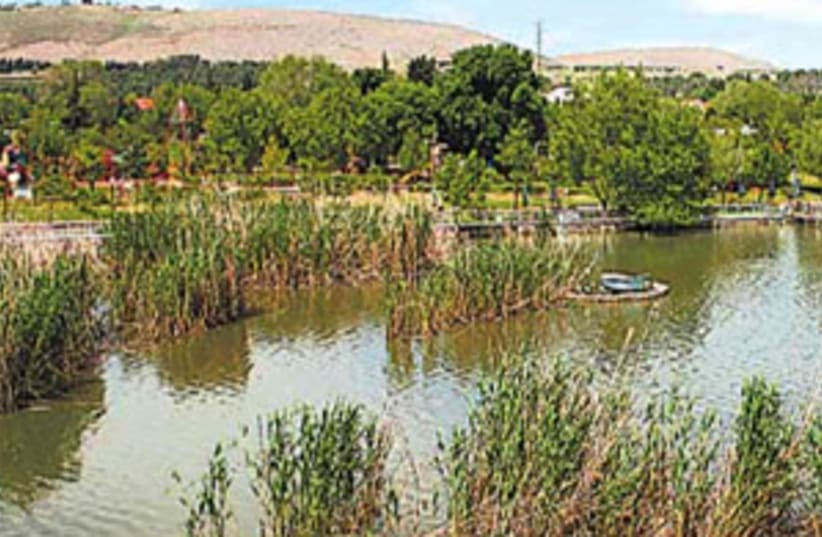Once upon a time there were three beautiful sisters. They lived in a village in eastern Upper Galilee, near the Aviv riverbed. Their father, a poverty-stricken farmer, found them rich, elderly husbands and set the wedding date.
The girls, however, loathed the men their father had chosen. The day before the joint celebration, the trio fled into the riverbed with the village men in hot pursuit. Suddenly, dizzy from the effort and panicky with fear, they saw the villagers approach. Deciding that staying in the wadi forever was preferable to returning home, the three sisters turned to stone on the slopes - and so did the men who were chasing them!
Take a hike through Nahal Aviv, one of the most beautiful riverbeds in Israel. During your three- to four-hour outing you will catch sight of the sisters and their pursuers - in the form of stones, of course - and view a plethora of flowers, trees, and a smattering of fauna. Shlomi Flax, a kibbutznik from the adjacent settlement of Yiron, suggests that you wear good hiking shoes for this rocky jaunt, bring several liters of water (in late spring and summer three liters is a must, he says) and don't forget a hat! Bird-watchers should bring a book that will help them identify the wadi's birds.
Hikers in good shape can leave the trail and climb up the steep slopes, where two large caves stand high above the wadi. Findings from the caves indicate that prehistoric man made a home there at least 6,000 years ago, and continued to do so, off and on, until the 15th century.
Your best bet is to have two cars handy for this hike. Leave one at the well-marked lot next to the Dishon Riverbed, located along Route 899 between Rehaniya and Kibbutz Yiron. Then take the second car north to the beginning of the trail: pass both entrances to Kibbutz Yiron and at the first sharp right curve in the road, carefully turn left onto a dirt road and park. Cross the highway to the other side with care, and then follow the blue-marked trail (two white stripes with a blue stripe in the middle) to the right into the riverbed.
MUSTARD FLOWERS, poppies, bear's breeches, and hawthorn trees are currently in full bloom. Summer hikers can devour masses of luscious wild raspberries, while fall visitors can enjoy the hawthorn's delicious crabapples. Dozens of trees offer ample shade in hot weather.
Although it is easier to maneuver the terrain while looking down, make sure to stop and gaze up at the cliffs on both sides of the wadi. Look for huge rocks on your right as you go deeper into the riverbed. Don't they seem ready to fall?
Soon a mass of rock in vertical layers of grey, brown, and black will appear on the slopes to your right. This is a large tznir - hard limestone with a soft middle that has dissolved in parts. Walk by, then look back for the best view of its overhangs as well as holes in the rock where palm doves nest.
You will see the 'three sisters' on your right not long after you spot the tznir. Further into the wadi, past the trio, you will spot several of the 'men' who chased them: one of them is obviously the village chief.
An enormous cave comes into view on your right, high up on the slopes. A transparent marker (missing the middle stripe) indicates where you should leave the trail and begin the difficult ascent to Me'arat Sulam, or Ladder Cave, so called because kibbutzniks from Yiron brought a ladder to the site. Its proper name is Me'arat Hahanaya (Parking Cave).
From the cave you have a great view of the region, including another, even larger, cave on the opposite slope. It is called Aviv Cave, and you will see squares of different sizes in the cave walls. They were hewn out by long-ago residents for reasons so far unknown.
When you finish exploring the rooms in Ladder Cave, carefully descend the dirt path that leads down to the wadi, then climb up another trail to Aviv Cave and have fun going from chamber to chamber. According to Shlomi, who guided us when we hiked the riverbed, it isn't clear whether Iron Age settlers here were Israelite, Phoenician, or some other group of people. In fact, Flax said, although the city of Yiron was granted to the Israelite tribe of Naphtali, ancient Yiron was probably located beneath the Lebanese village of Yirun and not where the kibbutz is today.
Settlers here would undoubtedly have reaped wild wheat, which grows here on the banks of the wadi. And they definitely processed grapes for wine; as you walk back down to the riverbed you will stumble upon a large, mosaic-covered ancient wine press. Continue walking: you are now heading towards Nahal Dishon, a wide riverbed that once flowed all year long.
Try and speak quietly near a massive collection of rocks inside the gully, for they are home to a group of hyraxes who will hide if you make too much noise. We saw one standing guard, ready to warn his friends if he sensed danger.
If you are quiet, you will also hear all kinds of songbirds and, with luck, spy the short-toed eagles and vultures that nest in Nahal Dishon. Then pass through a fence meant to keep cattle out of Nahal Aviv, ignore the cows grazing there, and you will end up at the Mekorot apparatus that 'borrows' water from the Dishon.
Turn right and follow red markers along the dirt road next to the dry riverbed. Soon you will reach your second car - and get the chance to take off your shoes and rub your feet!
Note: If you have only one car, you will leave the hike at Ladder Cave. Climb up past the cave, then turn around and walk back in the direction you came from.
